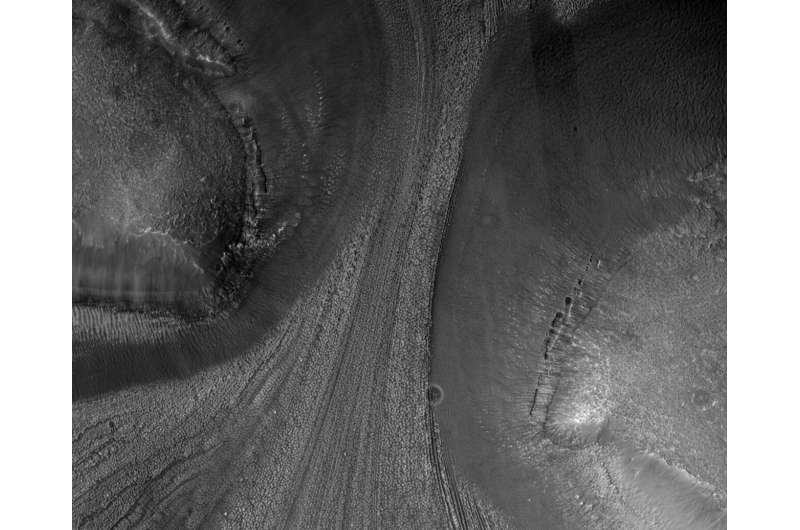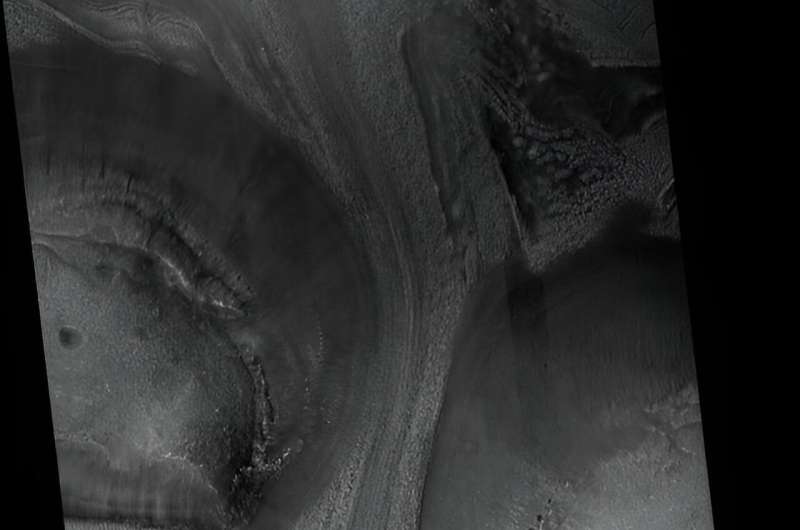This article has been reviewed according to Science X's editorial process and policies. Editors have highlighted the following attributes while ensuring the content's credibility:
fact-checked
trusted source
proofread
This sure looks like the movements of a glacier across ancient Mars

It is a scientific certainty that Mars was once a much different place, with a denser atmosphere, warmer temperatures, and where water once flowed. Evidence of this past is preserved in countless surface features, ranging from river channels and alluvial deposits to lakebeds.
However, roughly 4 billion years ago, the planet began to change into what we see today, an extremely cold and desiccated environment. Between all that, it is possible Mars experienced glacial and interglacial periods, which is evidenced by images like the one taken by the NASA Mars Reconnaissance Orbiter (MRO) shown above.
Evidence of glaciers on Mars includes landforms that resemble features on Earth that were shaped by the retreat of ice flows during interglacial periods. While most surface ice on Mars is confined to the polar ice caps, these landforms can be found in non-polar regions all across the planet. This feature was photographed by the High-Resolution Imaging Science Experiment (HiRISE), the main camera aboard the MRO. The full-sized image (shown below) offers a wider perspective and shows how the glacial deposit flowed downhill.

The black and white image measures 5 km (3 mi) across and shows linear ridges along the surface, exposed rocky debris, and infilling inside the floors of adjacent craters and valleys. This is similar to what is observed on Earth, where glaciers pick up rocks and soil from the landscape and carry it on their surfaces and subsurface. This allows "rock glaciers" to deposit material as they gradually retreat and flow downhill over many thousand years (or longer). This process creates a network of linear patterns scientists use to learn more about the history of ice flows.
These features indicate that, like Earth, Mars experienced periods of cooling and warming that coincided with periodic changes in its climate. These may have coincided with variations in Mars' axial tilt (obliquity), which is similar to Earth's orientation—25° vs. Earth's tilt of 23.4°. During cooler periods, ice flows would have advanced, expanded, and picked up debris from the landscape, followed by glacial retreats as the ice was lost through melting and sublimation. Over time, this process left rocks and minerals concentrated along long ridges and material infalls within low-lying regions.
These images are a reminder of Mars' highly dynamic climate, something it retains today despite all the changes it has experienced. These changes began roughly 4 billion years ago when Mars' core region began to cool rapidly, which is believed to have arrested its global magnetic field. Henceforth, Mars' warmer, denser atmosphere was slowly stripped away by solar wind, leading to global cooling and the gradual loss of its surface water. This led to Mars becoming the extremely cold and desiccated environment we see today.
Ironically, this transition ensured that the evidence for Mars' warmer, wetter past was also perfectly preserved. Without precipitation and more powerful winds (which require a dense atmosphere and a water cycle), these features did not experience weathering and erosion—as is the case here on Earth. Like river channels, clay minerals, and alluvial deposits, these preserved ridges prove that glaciers once existed on Mars beyond its polar regions.
Provided by Universe Today



















